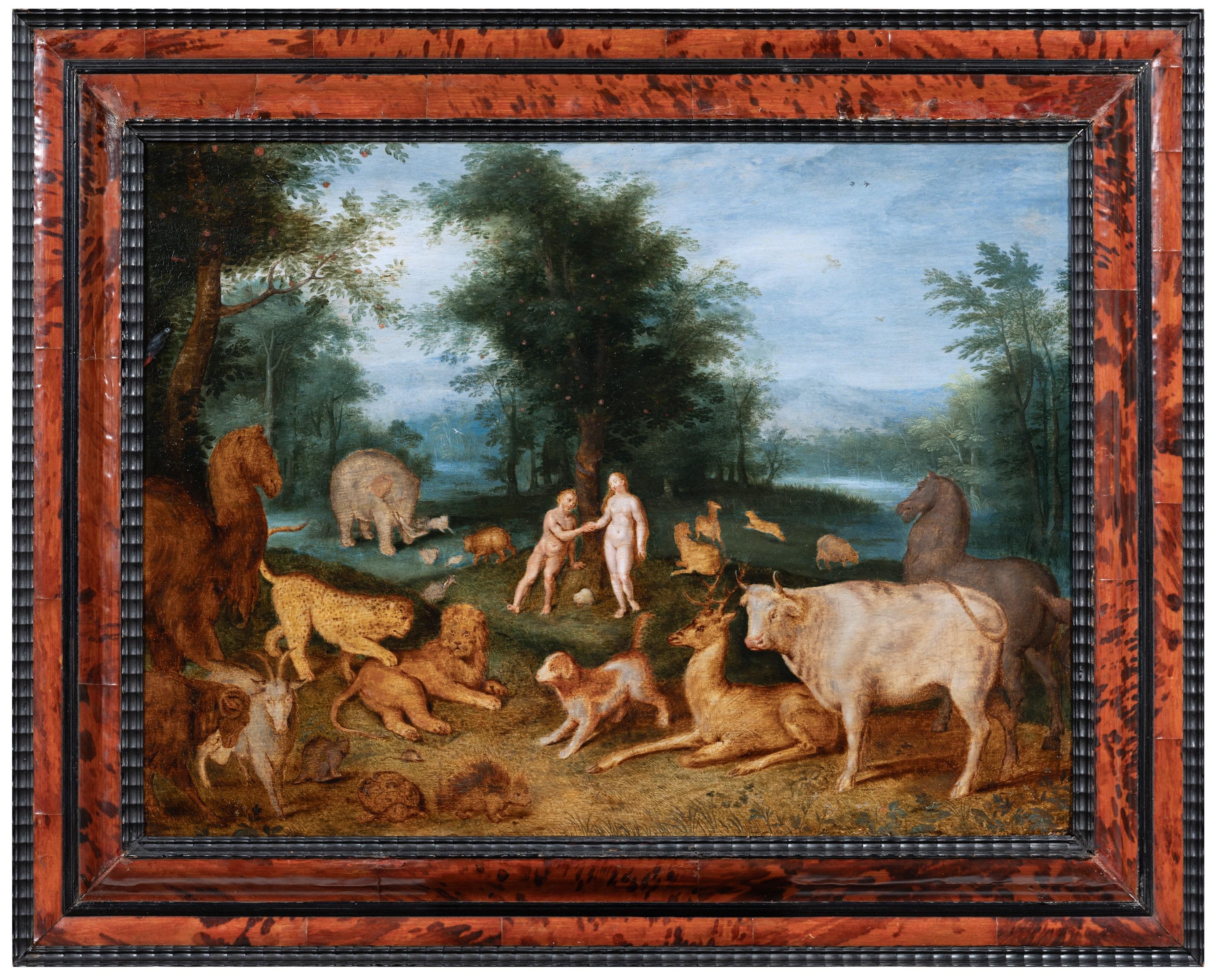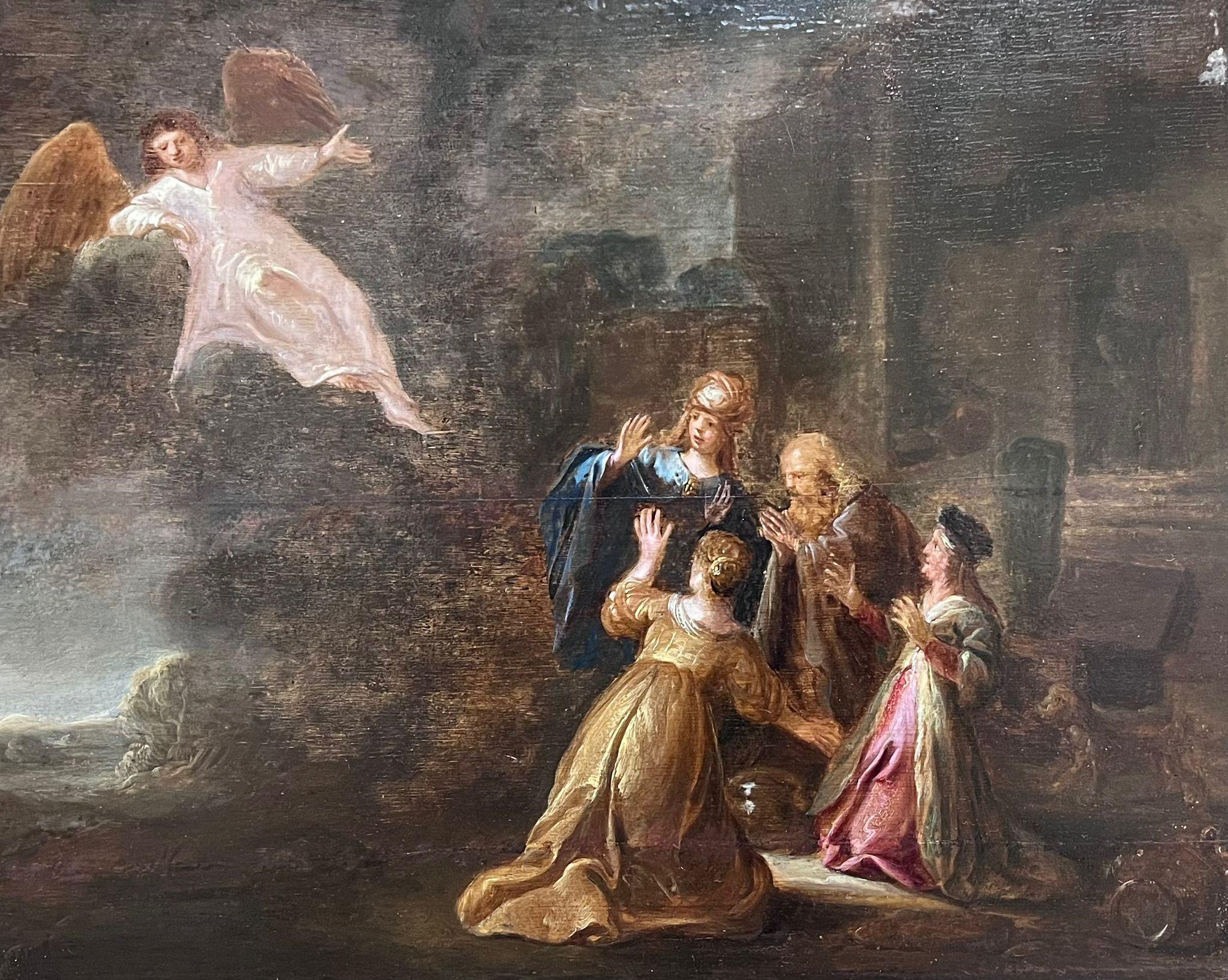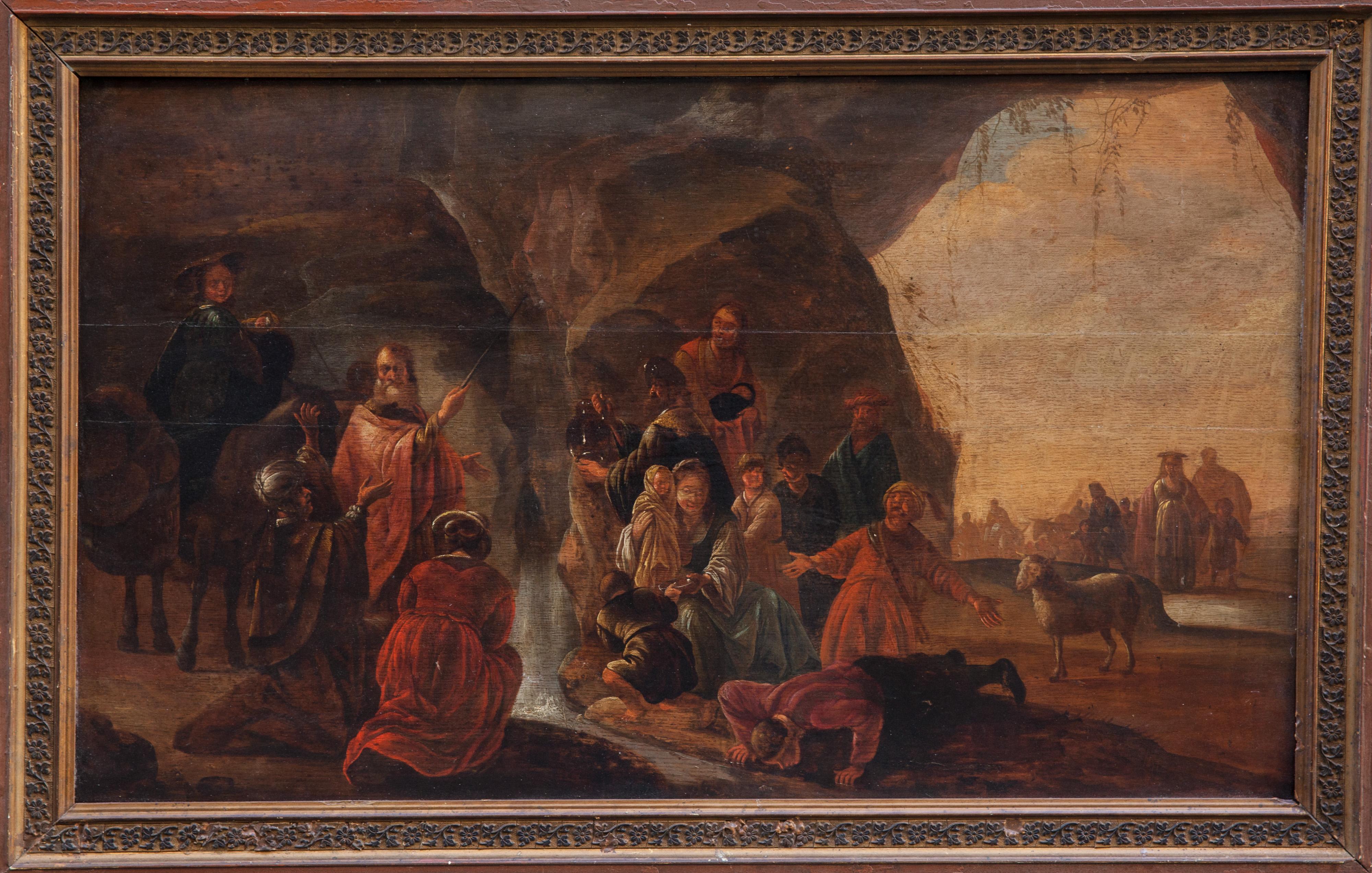Items Similar to The crossing of the Red Sea, 17th century Antwerp, studio Frans Francken
Want more images or videos?
Request additional images or videos from the seller
1 of 13
The crossing of the Red Sea, 17th century Antwerp, studio Frans Francken
About the Item
Crossing of the Red Sea
Workshop of Frans Francken II (1581-1642)
17th century Antwerp School
Oil on oak panel
Dimensions: h. 49.5 cm, w. 64.5 cm (19.49 in x 25.39 in)
Moulded and blackened wooden frame with wide mouldings, with inverted profile from the later period.
Framed dimensions: h. 82 cm, w. 97 cm (32.28 x 38.19 in)
Our panel illustrates one of the episodes of the Old Testament, recounted in the book of Exodus. After crossing the Red Sea, the Jewish people, safe and sound, rested on the shore while Pharaoh's army was swallowed up by the waves thanks to the intervention of Moses.
The crossing of the Red Sea comes as after centuries of captivity, the Jewish people, finally freed by Pharaoh, undertake the journey home, Pharaoh, filled with vengeance, decides to pursue them and so the Egyptian army perishes in the waves. The composition focuses in the foreground on an agitated group of figures gesticulating in the direction of the coffin with the remains of the patriarch Joseph, which has just been opened.
Many women with newborns make reference to the redemption of the firstborn. At their feet, strewn on the ground are the pieces of goldsmith's work stolen from the Egyptians before departure.
In the background we see Aaron accompanied by Moses who raises his staff in order to close the sea and annihilate Pharaoh's army in the giant whirlpool.
The profusion of numerous figures between the two planes gives the impression of an immense crowd, the horse standing out from the rest of the figures is a curious element invented by the painter, like the monkey seated in the foreground.
This way of mixing eras and continents is especially evident in the representation of the bucolic and hilly landscape typically Flemish with intense green colours, in contrast to the desert in which the Israelites found themselves after the departure from Egypt.
The painter's palette of diverse and varied colours further enriches the already elaborate composition.
Frans Francken painted the subject of the crossing of the Red Sea several times, varying the groups of figures and the compositional elements.
Several paintings relating this theme are mentioned in the monograph by Ursula Härting (Frans Francken II, 1989, pp. 236-239). Most of the versions of these works, executed by the workshop of Frans Francken and in particular by his son Hyeronimus Francken III, can be found in European museums as well as in private collections. In terms of content, the story is often paralleled with the political conflicts between Spain and the Republic of the Seven United Provinces, which culminated in the independence of the northern Netherlands in 1648.
Related works:
• Dorotheum sale, Vienna, 22/10/2019, by Hyeronimus Francken III, oil on copper, 50,5 x 67,5 cm
• Musée de Tessé, Le Mans, studio of Frans II Francken (1581-1642), oil on wood
• Koller sale, Zurich, 18/09/2009, lot n 3052, by Hyeronimus Francken III, oil on wood, 51,2 cm x 73,5 cm.
• Kunsthalle Karlsruhe, circa 1620, attributed to Hyeronimus Francken III, h. 47,5 cm, w. 71,8 cm
• Hamburg Kunsthalle, The Israelites Resting on the Red Sea, 1621, Tobias Verhaecht & Frans Francken II, oil on wood, h. 60.5, w. 105 cm
• Sale Rouillac, Vendôme 10/06/2018, oil on wood, h. 93,5, w. 123,5 cm. (the monkey is also present)
• Braunschweig, Herzog Anton Ulrich-Museum, oil on wood, h. 45 cm, w. 47 cm, Frans II Francken, c. 1625, signed ffranck (the scene around Joseph's tomb is very similar)
- Attributed to:Frans Francken II (1581 - 1642, Flemish)
- Dimensions:Height: 32.28 in (82 cm)Width: 38.19 in (97.01 cm)
- Medium:
- Movement & Style:
- Period:
- Condition:Very good original condition, cleaned and revarnished by our professionnal art restorer.
- Gallery Location:PARIS, FR
- Reference Number:1stDibs: LU2433213622312
About the Seller
No Reviews Yet
Vetted Seller
These experienced sellers undergo a comprehensive evaluation by our team of in-house experts.
1stDibs seller since 2023
Typical response time: 1 hour
- ShippingRetrieving quote...Ships From: PARIS, France
- Return PolicyA return for this item may be initiated within 3 days of delivery.
More From This SellerView All
- Adam and Eve in paradise, studio of Jan Brueghel the Younger, 17th centuryLocated in PARIS, FRStudio of Jan Brueghel the Younger 17th century Antwerp school Oil on oak panel, h. 37 cm, w. 49 cm Tortoiseshell veneered baroque style frame...Category
Mid-17th Century Old Masters Figurative Paintings
MaterialsOil, Wood Panel
- Ascension Day in Venice, Louis de Caullery (1582-1621), Flemish 17th centuryLocated in PARIS, FRAscension Day in Venice 17th century Antwerp School Attributed to Louis de Caullery (1582-1621) Oil on oak panel Dimensions: h. 19.68 in, w. 34.25 in Flemish style frame in ebonized ...Category
Early 17th Century Old Masters Landscape Paintings
MaterialsOil, Wood Panel
- Flemish 17th c., Allegory of war and peace, circa 1630, by Adriaen van StalbemtLocated in PARIS, FRAdriaen van Stalbemt (Antwerp, 1580-1662) Allegory of Peace and War, circa 1620-1630 Oil on oak panel: h. 49.5 cm, l. 73.2cm (19.29 x 28.74 in) Giltwood frame with laurel leaves, Lo...Category
Early 17th Century Old Masters Figurative Paintings
MaterialsOil, Panel
- The Triumph of the Infant Bacchus, workshop of H. Van Balen, 16th c. AntwerpBy Hendrick van BalenLocated in PARIS, FRThe Triumph of the Infant Bacchus, Workshop of Hendrick Van Balen (1575-1632) Antwerp, c.1630 Oil on copper, h. 28 cm (11.02 in), w. 35 cm (13.78 in) A large Roman 17th century golden painted frame Framed: h. 52 cm (20.47 in.), w. 58 cm (22.83 in) Our finely painted work depicts The Triumph of the Bacchus as a young boy and is one of the most popular mythological subjects in Antwerp at the beginning of the 17th century. Feasting, wine and fun are the themes that constantly appeal to the public. Thus unfolds before our eyes on our painting the procession composed of nymphs, baccantes, fauns, satyrs and children, their bodies naked, partially covered with brightly coloured draperies that help to brighten up the parade. Playing various instruments, dancing and drinking, while carrying vases and poles adorned with grapevines, participants to the rhythm of a noisy brass band make their way to an ancient temple standing on the right. The exaggerated gestures convey to us the frenzy of the excited crowd. The Child Bacchus follows the joyous procession, carried by satyrs and nymphs, crowned with ivy and joyfully raising a cup of wine. In the foreground, the drunken participants leave the procession, the children on the left and the group of bacchantes and satyrs on the right are resting among various objects scattered at their feet: cups, vases, ewers bear witness to the festivities in progress. In the background, a hilly landscape stretches out on the horizon, a semblance of calm that contrasts with the bustle of the foreground. The artist strives to multiply the many details, whether it be figures, costumes, flowers or vegetation, in order to demonstrate his know-how and the perfection of his execution. The acidulous palette with fresh and varied colours is characteristic of Hendrick Van Balen's works. There are several versions identical to ours with similar dimensions painted by Hendrick Van Balen and his workshop. Related works: • Koller Auction, Zurich, 21/09/2007, oil on copper, 28,5 x 37,4 cm. • Staatliche Kunsthalle, Karlsruhe, Inv. N° 809 (oil on copper, 40 x 53,5 cm) • Auktionshaus für Altertümer Glückselig, Vienne, 10/05/1932, ( oil on copper, 34 x 42 cm) • Gemäldegalerie of Pommersfelden, Schloss Weissenstein, oil on panel, 47 x 64 cm Hendrick Van Balen, Flemish painter, born and died in Antwerp (1575-1632). A pupil of Adam Van Noort, he entered the Guild of St. Luke in 1593, later trained in Italy and was Van Dyck's first teacher. He often painted small figures taken from scenes from the Bible or classical mythology, on paintings whose backgrounds and landscapes were painted by Josse de Momper...Category
17th Century Old Masters Figurative Paintings
MaterialsCopper
- A 17th c. Italian school, Capriccio with the Colosseum, circle of V. CodazziLocated in PARIS, FRA capriccio with the Colosseum in Roma 17th century Italian school Circle of Viviano Codazzi (1604-1670) Oil on canvas Dimensions: h. 35.43 in, w. 51.18 in Modern 17th century style ...Category
17th Century Old Masters Landscape Paintings
MaterialsCanvas, Oil
- Rest on the Flight into Egypt - Attributed to Pieter Van Avont - 17th c. FlemishBy Pieter van AvontLocated in PARIS, FRRest during the Flight into Egypt - The Virgin and Child with St. John the Baptist and the angels in a Landscape. Attributed to Pieter Van Avont (1600-1652) 17th century Antwerp School, circa 1630 Oil on oak panel, Dimensions: h. 38 cm, w. 50 cm (14.96 in x 19.68 in) Flemish style frame in ebonized and moulded wood Framed: h. 56 cm, w. 68.5 cm (22.04 in. x 26.97 in.) In the heart of a lush wooded landscape, the Virgin with Jesus rests in a green clearing accompanied by Saint John the Baptist and the cherubs. Seated to the left of the composition, the Virgin Mary holds the Child on her lap; the little Saint John the Baptist wearing the camel-skin tunic (his attribute) stands before Jesus to exchange a few caresses. On the right, the couple of cherubs are playing with the lamb of Saint John the Baptist, bringing a jovial character to the scene. A pair of gardening putti on the left pick flowers to bring bouquets to the Virgin and Jesus. Spring flowers such as tulips, daffodils and anemones that grow abundantly around them and enrich the composition with their shimmering colors. A lush rose bush blooms to the left of the figures offering delicate roses. (The rose is the flower associated with the Virgin Mary, who is the "mystical rose," the one that does not bear the "thorn of sin") At the feet of the Virgin are bunches of grapes (symbol of the future passion of Christ) as well as apples (symbol of the original fall of Man but also of the Redemption in Christ) In the foreground we find a wicker basket filled in profusion with beautiful flowers and guinea pigs nibbling on the blades of grass. In a cleverly arranged disorder, these elements of the still life with their strong symbolic power accentuate the religious theme, but are also an opportunity for the artist to demonstrate his know-how in the still life genre that is gaining momentum in Antwerp. The landscape behind the figures consists of a large tree with a twisted trunk and a luminous opening to the horizon placed on the right. We see Saint Joseph arriving with a donkey, a small reminder from the artist that the composition is associated with the episode of Rest during the flight into Egypt. The calm expanse of this bucolic forest opening onto the luminous distance, with its profusion of symbolic flowers and fruits, is particularly suited to this sacred scene. The theme of Jesus' sacrifice and his tragic fate is mitigated by cherubs who play with innocence and carelessness in the face of the fragility of life symbolized by cut flowers. The great mastery of the painter is manifested by the finesse of the drawing enhanced by the delicacy in the application of the brushstrokes bringing a multitude of details. The richness of the whole is exacerbated thanks to the choice of colours, this varied palette is an undeniable asset of our work. The virtuosity of our artist lies in his versatility, as much concerned with the success of the landscape and flowers as with the modelling of his figures. The cherubs with their naked bodies are gracefully illuminated by warm colours with subtle shadows, while the still life is rendered with astonishing realism, both in the precision of the drawing and in the countless shades of the flowers. There are several compositions similar to ours, of which below are the closest versions: • Sale, Jean-Claude Anaf et Associés, Lyon, 08/02/1998, attributed to Pieter Van Avont, oil on panel, h. 48 cm, l. 71 cm (recorded on RKD n° 31451). Comment: identical composition, only St Joseph with the donkey is different) • Christie's New York sale, 29/01/1998, Pieter Van Avont, oil on copper, h. 23.8 cm, w. 24.8 cm • Dorotheum sale, Vienna, 25/04/2017, Pieter Van Avont and Jan Breughel II, oil on copper, h .26 cm, w. 39 cm • Hermitage Museum, Saint Petersburg, Russia, Pieter Van Avont, oil on panel, h. 50.5 cm, w. 71.7 cm Peter van Avont, Flemish painter (Mechelen, 1600 - Antwerp. 1652) Born in Mechelen, he is mentioned in 1620 as a member of the painters' guild of his hometown. He left in 1 622 for Antwerp, where he was also a member of the guild. He collaborated with many painters, including Jan Brueguel the Younger, David Vinckboons, Lucas van Uden...Category
17th Century Old Masters Landscape Paintings
MaterialsOak, Oil
You May Also Like
- Antique English 19th century marine sceneBy William AndersonLocated in Woodbury, CTOutstanding English late 18th / early 19th century marine scene by one of Britain's best known and sought after painters. William (or Wiliam) Anderson (1757 – 27 May 1837) was a Scottish artist specializing in maritime and patriotic themes. He was well-regarded for his detailed and accurate portraits of ships under sail, exhibiting his works annually in London between 1787 and 1811 and then occasionally until 1834. Anderson influenced other artists, notably John Ward and others of the Hull school. Anderson's early life is obscure, but he is known to have trained as a shipwright before moving to London to become a maritime painter when he was about 30. His training served him well as a painter, providing "a practical nautical knowledge" of his subjects. He earned a reputation for "accuracy and refinement of detail" and was admired for his bright, clear colours. He worked in both oils and watercolours. He based his style on that of well-known Dutch maritime...Category
1810s Old Masters Figurative Paintings
MaterialsOil, Wood Panel
- Dutch School, 17th Century, Shipping in a Stiff Breeze, a City BeyondLocated in Stockholm, SEWe are delighted to present a significant piece from the Dutch School, most likely dating back to the late 17th century. This captivating painting showcases the dynamic force of nature with three ships vigorously navigating through stormy waters. The foreground is a scene of nautical struggle, as figures are depicted working intensely with the sails, steering, and bracing against the tumultuous sea. In the serene background, the silhouette of a quaint town emerges, with spires from churches and the outlines of various buildings is visible. This juxtaposition of the calm town against the chaotic foreground serves as a powerful reminder of the unpredictability of life and nature. Dominating the canvas, the sky occupies two-thirds of the painting, filled with brooding clouds that occasionally break to reveal patches of blue. The presence of birds adds a dynamic element to the otherwise ominous atmosphere. While the artist remains unknown, the work is quintessentially Dutch in its execution, with meticulous attention to detail and a profound understanding of maritime life. The painting's oval shape is quite distinctive and is complemented by a suitably antique octagonal black frame, which adds to its historical charm. This piece is a testament to the mastery of Dutch maritime painting...Category
17th Century Old Masters Landscape Paintings
MaterialsOak, Oil, Wood Panel
- Fine 17th Century Dutch Old Master Oil on Panel Angelic Visitation to FiguresBy Rembrandt van RijnLocated in Cirencester, GloucestershireThe Angelic Visitation Dutch School, mid 17th century circle of Rembrandt (Dutch 1606-1669) oil on wooden panel, framed in faux tortoiseshell style frame. framed: 25 x 28.75 painting...Category
17th Century Old Masters Figurative Paintings
MaterialsOil, Wood Panel
- Moses Strikes the Water from the Rock. XVII cent. Dutch school.Located in Firenze, ITMoses Strikes Water from the Rock Dutch school, XVII century. Workshop of Jacob de Wet (Haarlem, 1610-1675). Technique: Oil on oak wood panel, composed of 3 horizontal panels. In this evocative work, Moses stands in a cave, gathering the Israelites. There was no water to drink or for their cattle. The people were discontented in the desert. But Moses and Aaron listened to the voice of God. With Aaron’s staff, Moses struck the rock, and water gushed forth abundantly, quenching their thirst. Jacob de Wet’s workshop specializes in subjects from the Old and New Testaments. The recognizable rectangular format, simple compositions, and clear narratives define his style. The interplay of light and shadow, reminiscent of Rembrandt, adds timeless allure. The characters’ costumes, with their large hats and turbans...Category
17th Century Old Masters Figurative Paintings
MaterialsOil, Wood Panel
- Italian Landscape With Figures at a Waterfall by a Follower of Jan van HuysumBy Jan Van HuysumLocated in Stockholm, SEThere are so many details to fall in love with in this 18th-century painting depicting an Italianate landscape, for example, the delicately painted figures having a conversation and ...Category
Early 18th Century Old Masters Landscape Paintings
MaterialsOil, Wood Panel
- Shipping in Calm Waters, 18th Century Dutch Oil on Wood Panel, Man o WarLocated in Cirencester, GloucestershireShipping in Calm Waters Dutch School, 18th century oil painting on wood panel panel: 10 x 12.75 inches framed: 14 x 17 inches condition: very good, minor evidenc...Category
18th Century Old Masters Landscape Paintings
MaterialsWood Panel, Oil
Recently Viewed
View AllMore Ways To Browse
The Crossing
Antique Sea Painting
Jewish Wood
17th Century Copper
Spain Old Master Paintings
Spanish Old Master Paintings
17th Century Wood Panels
Terms Of Sale
Spanish Army
Horse Painting Old Masters
Old Safes
Spanish Jewish
Womens On Sale
Old Man Sea
Old Man And The Sea
The Old Man And The Sea
Used Sea Plane
Antique Wood Moulding





